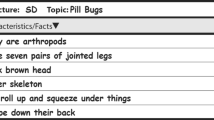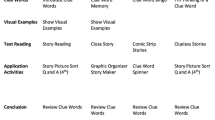Abstract
Explicit signals of important relationships in expository texts can provide efficient processing instructions for readers with strategic knowledge about text structures. However, such signal words do not help readers without strategic knowledge about use of text structures and signal words. This study provided the first detailed investigation about the effects of structure strategy instruction on understanding several types of comparative signal words in multi-paragraph expository texts. The study, set in 41 school districts, examined four comparative signal words generated by three groups of reading comprehenders in Grades 4, 5, 7, and 8 and how such understandings were impacted by instruction with the text structure strategy. Students in classrooms randomly assigned to structure strategy instruction showed more understanding of comparative signal words than those in the business as usual control. The intervention aided 4th, 5th, and 7th graders’ generation of all signal words, but more so for the more difficult signaling words that transitioned between paragraphs. For Grade 4 the intervention helped some reading comprehension groups more than others depending on signal word difficulty. For Grade 8 the intervention increased understanding of difficult signal words, but not the easiest signal word. Males in Grade 5 using the web-based structure strategy instruction improved their generation of the easiest signal word more than females, but females improved more on the difficult signal words. The comparison text structure and its signaling words appear ideal targets for instruction at upper elementary and middle school. The findings have implications for classroom instruction about text structures.

Similar content being viewed by others
References
Alexander, P. A. (2005). The path to competence: A lifespan developmental perspective on reading. Journal of Literacy Research, 37, 413–436. https://doi.org/10.1207/s15548430jlr3704_1.
Benjamini, Y., & Hochberg, Y. (1995). Controlling the false discovery rate: a practical and powerful approach to multiple testing. Journal of the Royal Statistical Society, 57(1), 289–300.
Bensoussan, M. (1990). Redundacy and the coherence cloze. Journal of Research in Reading, 13(1), 18–37.
Bohn-Gettler, C. M., & Kendeou, P. (2014). The interplay of reader goals, working memory, and text structure during reading. Contemporary Educational Psychology, 39(3), 206–219.
Cain, K., & Nash, H. M. (2011). The influence of connectives on young readers’ processing and comprehension of text. Journal of Educational Psychology, 103, 429–441. https://doi.org/10.1037/a0022824.
Crossley, S. A., Rose, D. F., Danekes, C., Rose, C. W., & McNamara, D. S. (2017). That noun phrase may be beneficial and this may not be: Discourse cohesion in reading and writing. Reading and Writing, 30, 569–589.
Crosson, A. C., & Lesaux, N. K. (2013). Does knowledge of connectives play a unique role in reading comprehension of English learners and English-only students? Journal of Research in Reading, 36(3), 241–260.
Geva, E. (2007). Conjunction use in school children’s oral language and reading. In R. Horowitz (Ed.), Talking texts: How speech and writing interact in school learning (pp. 271–294). Hillsdale, NJ: Erlbaum.
Graesser, A. C. (2007). An introduction to strategic reading comprehension. In D. S. McNamara (Ed.), Reading comprehension strategies: Theories, interventions, and technologies (pp. 3–26). New York: Lawrence Erlbaum Associates, Taylor & Francis Group.
Halliday, M. A. K., & Hasan, R. (1976). Cohesion in English. London, England: Longman.
Halpern, D. F. (2006). Assessing gender gaps in learning and academic achievement. In E. Anderman, P. H. Winne, P. A. Alexander, & L. Corno (Eds.), Handbook of educational psychology (2nd ed., pp. 635–654). Mahwah, NJ: Lawrence Erlbaum Associates.
Hebert, M., Bohaty, J. J., Nelson, J. R., & Brown, J. A. (2016). The effects of text structure instruction on informational text comprehension: A meta-analysis. Journal of Educational Psychology, 108, 609–629.
Lemarié, J., Lorch, R. F., Eyrolle, H., & Virbel, J. (2008). SARA: A text-based and reader-based theory of signaling. Educational Psychologist, 43(1), 27–48. https://doi.org/10.1080/00461520701756321.
Lenters, K. (2006). Resistance, struggle, and the adolescent reader. Journal of Adolescent & Adult Literacy, 50(2), 136–146. https://doi.org/10.1598/JAAL.50.2.6.
Levenston, E. A., Nir, R., & Blum-Kulka, S. (1984). Discourse analysis and the testing of reading comprehension by cloze techniques. In A. K. Pugh & J. M. Ulijn (Eds.), Reading for professional purposes. London: Heinemann.
Mayer, R. E. (2009). Multimedia learning (2nd ed.). New York: Cambridge University Press.
McClure, E., & Geva, E. (1983). The development of the cohesive use of adversative conjunctions in discourse. Discourse Processes, 6, 411–432. https://doi.org/10.1080/01638538309544575.
Meyer, B. J. F. (1975). The organization of prose and its effects on memory. Amsterdam: North-Holland.
Meyer, B. J. F. (1985). Prose analysis: Purposes, procedures, and problems. In B. K. Britton & J. Black (Eds.), Analyzing and understanding expository text (p. 11-64, 269-304). Hillsdale, NJ: Erlbaum.
Meyer, B. J. F. (2003). Text coherence and readability. Topics in Language Disorders, 23, 204–221.
Meyer, B. J. F., Brandt, D. M., & Bluth, G. J. (1980). Use of the top-level structure in text: Key for reading comprehension of ninth-grade students. Reading Research Quarterly, 16, 72–103.
Meyer, B. J. F., & Freedle, R. O. (1984). Effects of discourse type on recall. American Educational Research Journal, 21, 121–143.
Meyer, B. J. F., Middlemiss, W., Theodorou, E., Brezinski, K. L., McDougall, J., & Bartlett, B. J. (2002). Effects of structure strategy instruction delivered to fifth-grade children via the Internet with and without the aid of older adult tutors. Journal of Educational Psychology, 94, 486–519.
Meyer, B. J. F., & Poon, L. W. (2001). Effects of structure strategy training and signaling on recall of text. Journal of Educational Psychology, 93, 141–159.
Meyer, B. J. F., & Ray, M. N. (2011). Structure strategy interventions: Increasing reading comprehension of expository text. International Electronic Journal of Elementary Education, 4(1), 127–152.
Meyer, B. J. F., Ray, M. N., & Middlemiss, W. (2012). Children’s use of comparative text signals: the relationship between age and comprehension ability. Discours. Revue de linguistique, psycholinguistique et informatique, 10, 1–25.
Meyer, B. J. F., & Rice, G. E. (1982). The interaction of reader strategies and the organization of text. Text-Interdisciplinary Journal for the Study of Discourse, 2(1–3), 155–192.
Meyer, B. J. F., & Rice, G. E. (1989). Prose processing in adulthood: The text, the reader, and the task. In L. W. Poon, D. C. Rubin, & B. A. Wilson (Eds.), Everyday cognition in adulthood and later life (pp. 157–194). New York: Cambridge University Press.
Meyer, B. J. F., & Wijekumar, K. (2016). Intelligent tutoring of the structure strategy: A reading strategy tutor. In S. A. Crossley & D. S. McNamara (Eds.), Adaptive educational technologies for literacy instruction (pp. 82–103). New York, NY: Routledge Publishers, Taylor & Francis Group.
Meyer, B. J. F., Wijekumar, K., & Lin, Y. (2011). Individualizing a Web-based structure strategy intervention for fifth graders’ comprehension of nonfiction. Journal of Educational Psychology, 103(1), 140–168.
Meyer, B. J. F., Wijekumar, K., Middlemiss, W., Higley, K., Lei, P., Meier, C., et al. (2010). Web-based tutoring of the structure strategy with or without elaborated feedback or choice for fifth- and seventh-grade readers. Reading Research Quarterly, 45(1), 62–92.
Pyle, N., Vasquez, A. C., Lignugaris/Kraft, B., Gillam, S. L., Reutzel, D. R., Olszewski, A., et al. (2017). Effects of expository text structure interventions on comprehension: A meta-analysis. Reading Research Quarterly, 52(4), 469–501. https://doi.org/10.1002/rrq.179.
Ray, M. N., & Meyer, B. J. F. (2011). Individual differences in children’s knowledge of expository text structures: A review of literature. International Electronic Journal of Elementary Education, 4, 67–82.
Richgels, D. J., McGee, L. M., Lomax, R. G., & Sheard, C. (1987). Awareness of four text structures: Effects on recall of expository text. Reading Research Quarterly, 22, 177–196. https://doi.org/10.2307/747664.
Sanchez, E., Garcia, J. R., & Bustos, A. (2016). Does rhetorical competence moderate the effect of rhetorical devices on the comprehension of expository texts beyond general comprehension skills? Reading and Writing, 30(3), 439–462. https://doi.org/10.1007/s11145-016-9684-2.
Schloss, B. J. (2017). Predicting concept evolution during naturalistic reading with simultaneous eye-tracking and fMRI (Unpublished master’s thesis). The Pennsylvania State University, University Park, PA.
Spooren, W. P. M., & Sanders, T. (2008). The acquisition order of coherence relations: On cognitive complexity in discourse. Journal of Pragmatics, 40, 2003–2026. https://doi.org/10.1016/j.pragma.2008.04.021.
van den Broek, P., Young, M., Tzeng, Y., & Linderholm, T. (1999). The Landscape model of reading: Inferences and the online construction of a memory representation. In S. R. Goldman & H. van Oostendorp (Eds.), The construction of mental representations during reading (pp. 71–98). Mahwah, NJ: Lawrence Erlbaum Associates.
Vauras, M., Kinnunen, R., & Kuusela, L. (1994). Development of text-processing skills in high-, average-, and low-achieving primary school children. Journal of Reading Behavior, 264, 361–389.
Welie, C., Schoonen, R., Kuiken, F., & van den Bergh, H. (2016). Expository text comprehension in secondary school: For which readers does knowledge of connectives contribute the most? Journal of Research in Reading, 40, S42–S65. https://doi.org/10.1111/1467-9817.12090.
Wiederholt, J. L., & Blalock, G. (2000). Gray silent reading tests. Austin, TX: Pro-Ed.
Wijekumar, K. K., Meyer, B. J. F., & Lei, P. (2012). Large-scale randomized controlled trial with 4th graders using intelligent tutoring of the structure strategy to improve nonfiction reading comprehension. Journal of Educational Technology Research and Development, 60, 987–1013. https://doi.org/10.1007/s11423-012-9263-4.
Wijekumar, K(. K)., Meyer, B. J. F., & Lei, P. (2017). Web-based text structure strategy instruction improves seventh graders’ content area reading comprehension. Journal of Educational Psychology, 109(6), 741–760.
Wijekumar, K., Meyer, B. J. F., Lei, P., Lin, Y., Johnson, L. A., Spielvogel, J. A., et al. (2014). Multisite randomized controlled trial examining intelligent tutoring of structure strategy for fifth-grade. Journal of Research on Educational Effectiveness., 7, 331–357. https://doi.org/10.1080/19345747.2013.853333.
Williams, J. P., Kao, J. C., Pao, L. S., Ordynans, J. G., Atkins, J. G., Cheng, R., et al. (2016). Close analysis of texts with structure (CATS): An intervention to teach reading comprehension to at-risk second graders. Journal of Educational Psychology, 108(8), 1061–1077. https://doi.org/10.1037/edu0000117.
Acknowledgements
The research reported here was supported by the Institute of Education Sciences, U.S. Department of Education, through Grants R305G030072, R305A080133, and R305A120593 to The Pennsylvania State University and IES Grant R305A150057 to Texas A & M University. The opinions expressed are those of the authors and do not represent views of the Institute or the U.S. Department of Education.
Author information
Authors and Affiliations
Corresponding author
Rights and permissions
About this article
Cite this article
Meyer, B.J.F., Wijekumar, K. & Lei, P. Comparative signaling generated for expository texts by 4th–8th graders: variations by text structure strategy instruction, comprehension skill, and signal word. Read Writ 31, 1937–1968 (2018). https://doi.org/10.1007/s11145-018-9871-4
Published:
Issue Date:
DOI: https://doi.org/10.1007/s11145-018-9871-4




